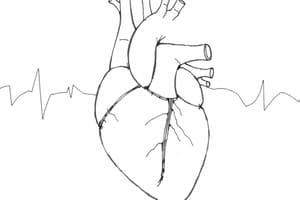Podcast
Questions and Answers
What are the two phases of the cardiac cycle?
What are the two phases of the cardiac cycle?
Systole and diastole
The sympathetic nervous system decreases heart rate.
The sympathetic nervous system decreases heart rate.
False (B)
Which of the following is NOT a factor that influences stroke volume?
Which of the following is NOT a factor that influences stroke volume?
- Contractility
- Blood type (correct)
- Arterial pressure (afterload)
- Venous return
What is the primary function of the SA node?
What is the primary function of the SA node?
Which of the following is a local control mechanism that regulates arteriolar blood flow?
Which of the following is a local control mechanism that regulates arteriolar blood flow?
What is the role of L-type calcium channels in ventricular cardiomyocyte contractility?
What is the role of L-type calcium channels in ventricular cardiomyocyte contractility?
Flashcards
Electrical Conduction System of the Heart
Electrical Conduction System of the Heart
The electrical pathway through the heart that controls the rhythm of heartbeats. This pathway involves specialized cells that generate and conduct electrical impulses.
Automaticity of the Heart
Automaticity of the Heart
The ability of the heart to generate its own electrical impulses, causing it to beat rhythmically.
Sequence of Cardiac Excitation
Sequence of Cardiac Excitation
The specific sequence of events that occur during each heartbeat, from the initial electrical impulse to the contraction and relaxation of heart chambers.
Echocardiogram
Echocardiogram
Signup and view all the flashcards
Systole
Systole
Signup and view all the flashcards
Diastole
Diastole
Signup and view all the flashcards
Stroke Volume
Stroke Volume
Signup and view all the flashcards
Heart Rate
Heart Rate
Signup and view all the flashcards
Cardiac Output
Cardiac Output
Signup and view all the flashcards
Autonomic Nervous System
Autonomic Nervous System
Signup and view all the flashcards
Parasympathetic Nervous System
Parasympathetic Nervous System
Signup and view all the flashcards
Sympathetic Nervous System
Sympathetic Nervous System
Signup and view all the flashcards
Acetylcholine
Acetylcholine
Signup and view all the flashcards
Norepinephrine
Norepinephrine
Signup and view all the flashcards
Preload
Preload
Signup and view all the flashcards
Afterload
Afterload
Signup and view all the flashcards
Mean Arterial Pressure (MAP)
Mean Arterial Pressure (MAP)
Signup and view all the flashcards
Pulse Pressure
Pulse Pressure
Signup and view all the flashcards
Total Peripheral Resistance (TPR)
Total Peripheral Resistance (TPR)
Signup and view all the flashcards
Contractility
Contractility
Signup and view all the flashcards
Local (Intrinsic) Controls
Local (Intrinsic) Controls
Signup and view all the flashcards
Myogenic Autoregulation
Myogenic Autoregulation
Signup and view all the flashcards
Active Hyperemia
Active Hyperemia
Signup and view all the flashcards
Reactive Hyperemia
Reactive Hyperemia
Signup and view all the flashcards
Flow Autoregulation
Flow Autoregulation
Signup and view all the flashcards
Cardiac Reserve
Cardiac Reserve
Signup and view all the flashcards
Cardiac Remodeling
Cardiac Remodeling
Signup and view all the flashcards
Heart Failure
Heart Failure
Signup and view all the flashcards
Study Notes
Human Physiology Lecture: The Circulatory System and Heart: Part 2
- The lecture covers the electrical conduction system of the heart and the sequence of cardiac excitation.
- An echocardiogram is used to display the electrical activity of the heart over time.
- The action potential is a brief change in membrane potential, crucial for nerve and muscle function.
- Depolarization: A change from a negative to a positive charge.
- Repolarization: A change from a positive to a negative charge.
- The electrical conduction system, including the SA node, AV node, and bundle branches.
- The sequence of cardiac excitation, showing atrial excitation followed by ventricular excitation and relaxation.
- The cardiac cycle comprises the systole (contraction) and diastole (relaxation) phases, relating to blood flow in the heart.
- Cardiac output (CO) relates to heart rate (HR) and stroke volume (SV).
- The autonomic nervous system regulates heart rate (HR).
- The autonomic nervous system influences the heart.
- Sympathetic and parasympathetic nerves affect the heart.
- Specific receptors in the heart, like muscarinic and beta1 adrenergic receptors, respond to hormones like norepinephrine/epinephrine.
- Factors like venous return, end-diastolic volume (EDV), and afterload, influence stroke volume (SV), a major component of cardiac output (CO).
- Different types of cardiac action potentials (Sino-Atrial Node AP and Ventricular AP).
- The difference between ventricular AP and skeletal muscle AP.
- The relationship between membrane potential changes in the heart and ventricular contraction.
- The concept of preload, afterload, and contractility.
- Measurement of cardiac activity includes HR, SV, and CO.
- The flow of blood through the heart: diastole, systole, and the different pressures involved.
- The concepts of pressure-volume loops to understand the heart's functions, including end-systolic volume (ESV), and end-diastolic volume (EDV).
- Stroke volume (SV) is calculated as the difference between end-diastolic volume (EDV) and end-systolic volume (ESV).
- Cardiac output (CO) is calculated as the product of heart rate (HR) and stroke volume (SV).
- Factors contributing to systemic pressure, including blood volume, venous tone, and the action of the heart and vessels.
- Arterioles' role in regulating blood flow to different organs in response to the body's need.
- Mechanisms to regulate blood flow through the local intrinsic and extrinsic mechanisms (using nerves, hormones, autoregulation).
- Specific components (like arterioles, capillaries, veins) and their function in controlling blood flow and pressure.
Additional Concepts
- Components of the heart (atria, ventricles, valves etc.)
- The role of pacemaker cells in spontaneous heart beat activity
- Mechanisms of blood flow regulation and pressure maintenance, and implications in disease
- Different cardiovascular pressures and their relation to blood movement
- Heart health and possible disease scenarios.
Studying That Suits You
Use AI to generate personalized quizzes and flashcards to suit your learning preferences.




